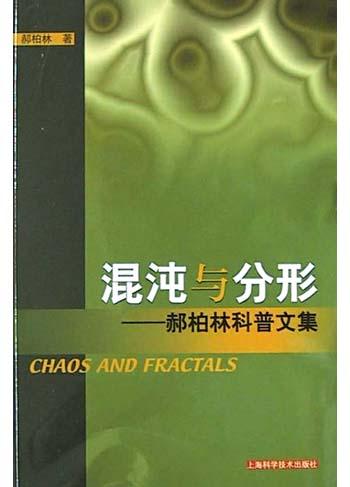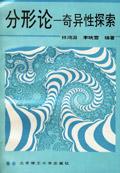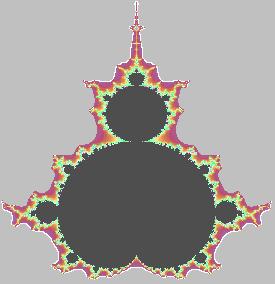-

无处不在的分形
《无处不在的分形(第2版)》主要内容:I acknowledge and thank many people for their help with this book. In particular I thank Alan Sloan, who has unceasingly encouraged me, who wrote the first Collage software, and who so clearly envisioned the application of iterated function systems to image compression and communications that he founded a company named Iterated Systems Incorporated. Edward Vrscay, who taught the first course in deterministic fractal geometry at Georgia Tech, shared his ideas about how the course could be taught, and suggested some subjects for inclusion in this text. Steven Demko, who collaborated with me on the discovery of iterated function systems, made early detailed proposals on how the subject could be presented to students and scientists, and provided comments on several chapters. Andrew Harrington and Jeffrey Geronimo, who discovered with me orthogonal polynomials on Julia sets. My collaborations with them over five years formed for me the foundation on which iterated function systems are built. Watch for more papers from us! Les Karlovitz, who encouraged and supported my research over the last nine years, obtained the time for me to write this book and provided specific help, advice, and direction. His words can be found in some of the sentences in the text. Gunter Meyer, who has encouraged and supported my research over the last nine years. He has often given me good advice. Robert Kasriel, who taught me some topology over the last two years, corrected and rewrote my proof of Theorem 7.1 in Chapter II and contributed other help and warm encouragement. Nathanial Chafee, who read and corrected Chapter II and early drafts of Chapters III and IV. His apt constructive comments have increased substantially the precision of the writing. John Elton, who taught me some ergodic theory, continues to collaborate on exciting research into iterated function systems, and helped me with many parts of the book. Daniel Bessis and Pierre Moussa, who are filled with the wonder and mystery of science, and taught me to look for mathematical events that are so astonishing that they may be called miracles. Research work with Bessis and Moussa at Saclay during 1978, on the Diophantine Moment Problem and Ising Models, was the seed that grew into this book. Warren Stahle, who provided some of his experimental research results. -

Fractal Geometry
Since its original publication in 1990, Kenneth Falconera s Fractal Geometry: Mathematical Foundations and Applications has become a seminal text on the mathematics of fractals. It introduces the general mathematical theory and applications of fractals in a way that is accessible to students from a wide range of disciplines. This new edition has been extensively revised and updated. It features much new material, many additional exercises, notes and references, and an extended bibliography that reflects the development of the subject since the first edition. aeo Provides a comprehensive and accessible introduction to the mathematical theory and applications of fractals. aeo Each topic is carefully explained and illustrated by examples and figures. aeo Includes all necessary mathematical background material. aeo Includes notes and references to enable the reader to pursue individual topics. aeo Features a wide selection of exercises, enabling the reader to develop their understanding of the theory. aeo Supported by a Web site featuring solutions to exercises, and additional material for students and lecturers. Fractal Geometry: Mathematical Foundations and Applications is aimed at undergraduate and graduate students studying courses in fractal geometry. The book also provides an excellent source of reference for researchers who encounter fractals in mathematics, physics, engineering, and the applied sciences. Also by Kenneth Falconer and available from Wiley: Techniques in Fractal Geometry ISBN 0--471--95724--0 Please click here to download solutions to exercises found within this title: http://www.wileyeurope.com/fractal -

分形算法与程序设计
-

混沌与分形
本文集选录了科普、短论和自述三部分的文章,共40余篇。即《统计物理学介绍》、《科学政策要容得百家争鸣》、《我们走上新的行程》等。 -

分形论-奇异性探索
分形论是当代新兴学术思潮中的明珠。本书通俗系统地介绍了分形论的基本概念、原理和计算技巧,论述了混沌现象和奇异吸引子;讨论了分形论在物理、化学、材料、生物、医学、地震、计算机仿真、电子技术和社会科学中的应用。特别就凝聚、相变、渗流、自组织现象、表面、高分子、薄膜晶化、准晶形成、纳米晶体、断裂、灵感思维、人体科学、生理、穴位群、生命与健康、征服癌症、农业增产和石油开采等广泛领域中的分形问题作了探讨;介绍了诸位科学上的传奇人物。 本书可供大学师生、中小学教师科技工作才和社会科学工作者阅读与教学用书。 -

分形艺术
本书以优美的笔调简明介绍了分形概念,从科学与艺术相结合的角度尝试分析了分形图形艺术的意义和前景。更为重要的是,作者详细讲述了制作精美分形的技巧,并给出了大量源程序。作者的用意就是推广普及分形艺术,使更多的读者在最短的时间里掌握必要的技巧,能够亲手制作出更多更美的图形。 第一章 分形故事多 1.1 简单说来 1.2 有人创造了fractal这个词 1.3 “分形”之由来 1.4 语词的魅力 1.5 分形纪事 1.6 球形鸡与分形牛 1.7 标度:人给自然立法 1.8 “模型八”与原子 1.9 作为认知方法和解释工具的分形概念 1.10 分数维数:从拓扑维到度量维 1.11 分形与生成哲学 第二章 分形图形艺术 2.1 艺术的含义 2.2 时代的反驳 2.3 分形作为艺术 2.4 也谈真、善、美 2.5 分形艺术在中国的境遇 2.6 分形艺术图形生成方法与发展前景 2.7 超大分形艺术图形与装饰艺术 2.8 革命:艺术与新几何学 2.9 刚刚开始的话题:信息时代的艺术 第三章 计算机上作图 3.1 数的哲学 3.2 计算机不只是计算 3.3 操作系统与文件 3.4 计算机屏幕坐标 3.5 孟塞尔标色体系及其他 3.6 色彩与RGB值 3.7 CMYK分色片 3.8 图形文件的格式 3.9 图形初始化 3.10 微机图形功能一瞥 第四章 传统分形:从反例到主角 4.1 从巨人丢勒谈起 4.2 康托尔集合 4.3 皮亚诺曲线与希尔伯特曲线 4.4 柯赫曲线 4.5 谢尔宾斯基地毯 第五章 林氏系统与迭代函数系统 5.1 林氏系统 5.2 实例与伪码 5.3 供实验的林氏系统数据表 5.4 迭代函数系统方法 5.5 扩散置限凝聚模型 第六章 复平面上的迭代 6.1 复数四则运算与迭代 6.2 芒德勃罗集 6.3 朱丽亚集 6.4 广义芒德勃罗集和朱丽亚集 6.5 高维芒德勃罗集与朱丽亚集 6.6 牛顿法求根 第七章 对称图案与平面铺砌 7.1 对称的奥秘 7.2 关注对称性的世纪 7.3 周期网和非周期网 7.4 对称斑图的等能面画法 7.5 平面铺砌的林氏系统生成 第八章 实映射分形图 8.1 一维逻辑斯蒂映射 8.2 里雅普诺夫指数 8.3 双浑沌映射 8.4 标准映射 8.5 埃农保面积映射 8.6 国王映射 8.7 三翅鹰映射 第九章 微分方程系统 9.1 描述大自然的模型 9.2 龙格-库塔积分法 9.3 洛仑兹浑沌 9.4 若斯勒浑沌 9.5 布鲁塞尔子 第十章 软件Fractint 19.5简介 10.1 从网上获取最新版本的Fractint软件 10.2 创建Fractint软件说明书 10.3 操作举例 10.4 调色板编制与实时编辑 10.5 Fractint 19.5全部源代码 尾声:分形路漫漫 主要参考文献与彩页目录 后记 索引